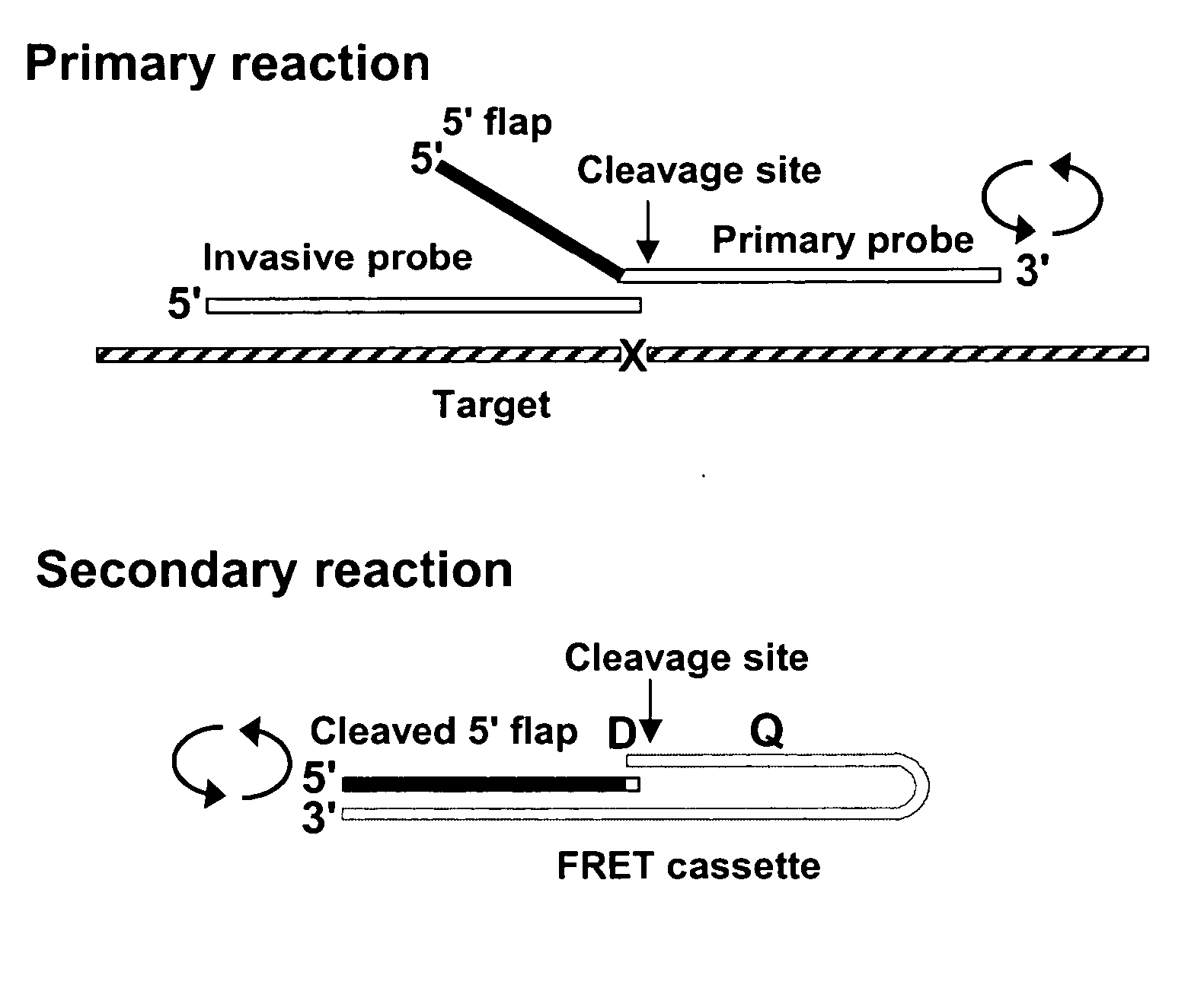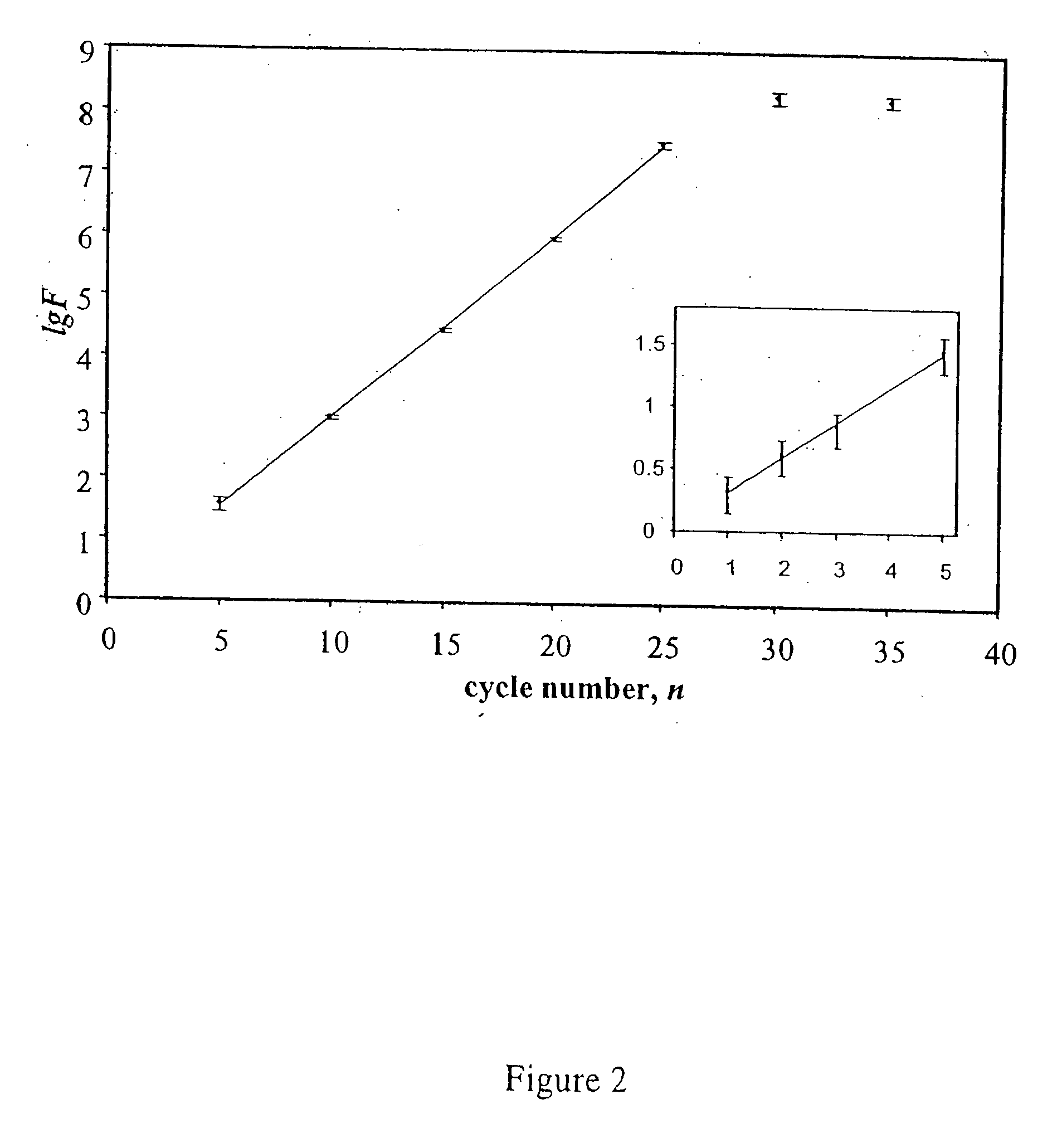Single step detection assay
a single-step detection and assay technology, applied in the field of single-step detection assay, can solve the problems of high risk of carry-over contamination of pcr applications, difficult to obtain standard biological samples of genomic dna, and difficult to achieve the effect of achieving the effect of achieving the effect of reducing the risk of carry-over contamination, and reducing the risk of contamination
- Summary
- Abstract
- Description
- Claims
- Application Information
AI Technical Summary
Benefits of technology
Problems solved by technology
Method used
Image
Examples
example 1
Designing a 10-PLEX (Manual): Test for INVADER Assays
[0277] The following experimental example describes the manual design of amplification primers for a multiplex amplification reaction, and the subsequent detection of the amplicons by the INVADER assay.
[0278] Ten target sequences were selected from a set of pre-validated SNP-containing sequences, available in a TWT in-house oligonucleotide order entry database. Each target contains a single nucleotide polymorphism (SNP) to which an INVADER assay had been previously designed. The INVADER assay oligonucleotides were designed by the INVADER CREATOR software (Third Wave Technologies, Inc. Madison, Wis.), thus the footprint region in this example is defined as the INVADER “footprint”, or the bases covered by the INVADER and the probe oligonucleotides, optimally positioned for the detection of the base of interest, in this case, a single nucleotide polymorphism. About 200 nucleotides of each of the 10 target sequences were analyzed fo...
example 2
Design of 101-PLEX PCR using the Software Application
[0295] Using the TWT Oligo Order Entry Database, 144 sequences of less than 200 nucleotides in length were obtained, with SNPs annotated using brackets to indicate the SNP position for each sequence (e.g. NNNNNNN[N(wt) / N(mt)]NNNNNNNN). In order to expand sequence data flanking the SNP of interest, sequences were expanded to approximately 1 kB in length (500 nts flanking each side of the SNP) using BLAST analysis. Of the 144 starting sequences, 16 could not expanded by BLAST, resulting in a final set of 128 sequences expanded to approximately 1 kB length. These expanded sequences were provided to the user in Excel format with the following information for each sequence; (1) TWT Number, (2) Short Name Identifier, and (3) sequence. The Excel file was converted to a comma delimited format and used as the input file for Primer Designer INVADER CREATOR v1.3.3. software (this version of the program does not screen for FRET reactivity of...
example 3
Use of the INVADER Assay to Determine Amplification Factor of PCR
[0298] The INVADER assay can be used to monitor the progress of amplification during PCR reactions, i.e., to determine the amplification factor F that reflects efficiency of amplification of a particular amplicon in a reaction. In particular, the INVADER assay can be used to determine the number of molecules present at any point of a PCR reaction by reference to a standard curve generated from quantified reference DNA molecules. The amplification factor F is measured as a ratio of PCR product concentration after amplification to initial target concentration. This example demonstrates the effect of varying primer concentration on the measured amplification factor.
[0299] PCR reactions were conducted for variable numbers of cycles in increments of 5, i.e., 5, 10, 15, 20, 25, 30, so that the progress of the reaction could be assessed using the INVADER assay to measure accumulated product. The reactions were diluted seria...
PUM
| Property | Measurement | Unit |
|---|---|---|
| melting temperature | aaaaa | aaaaa |
| melting temperature | aaaaa | aaaaa |
| melting temperatures | aaaaa | aaaaa |
Abstract
Description
Claims
Application Information
 Login to View More
Login to View More - R&D
- Intellectual Property
- Life Sciences
- Materials
- Tech Scout
- Unparalleled Data Quality
- Higher Quality Content
- 60% Fewer Hallucinations
Browse by: Latest US Patents, China's latest patents, Technical Efficacy Thesaurus, Application Domain, Technology Topic, Popular Technical Reports.
© 2025 PatSnap. All rights reserved.Legal|Privacy policy|Modern Slavery Act Transparency Statement|Sitemap|About US| Contact US: help@patsnap.com



